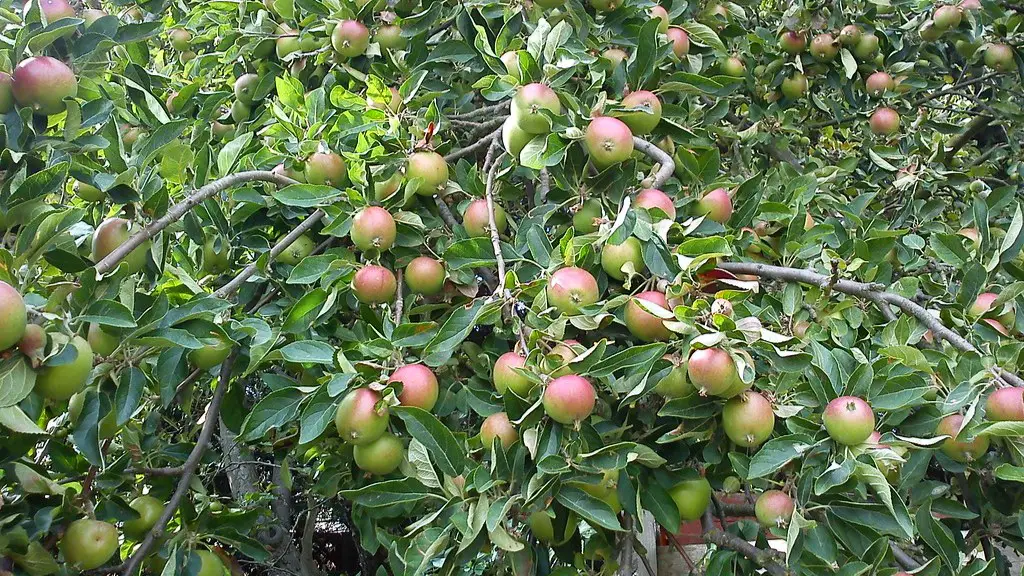Avocados (Persea americana) are considered a superfood due to their nutritious, creamy texture, and low calorie content. They’re a staple in many cuisines, from Mexican dishes to salads to avocado toast, and they provide a wide range of health benefits. Avocados are grown on trees, but many people don’t stop to consider what kind of tree an avocado is and how large it can get.
Avocado trees come in a range of sizes, depending on the variety and the environmental conditions they’re grown in. Generally speaking, avocado trees are considered medium-sized trees and can reach up to 40 feet in height and 40 feet in width. While some varieties can reach even larger sizes (such as the popular Hass variety, which can reach heights of up to 60 feet), most domestic avocado trees tend to be smaller.
Avocado trees require plenty of sunlight, water, and nutrients to thrive and can be grown in a variety of climates. The trees need to be sheltered from wind and frost if they’re grown in cooler climates, and they’re best suited to warm, humid locations. The trees need regular pruning to maintain their shape and size, and to ensure they’re getting enough sun. Additionally, the trees need to be topped, which involves removing the tops of the branches to keep the tree from becoming too tall.
Avocados are usually grown in containers, which helps to keep the trees at a manageable size. Putting the trees in pots is beneficial, as it also helps to protect them from pests and extreme weather conditions. Additionally, the trees are usually planted in well-draining soil and are regularly fertilized to ensure they stay healthy and productive. The amount of sunlight, water, and nutrients that the tree receives will determine how big it grows.
Experts agree that the size of an avocado tree is determined by a variety of factors, from the climate to the type of tree, to the conditions it is grown in. Coconut trees generally reach greater heights than avocado trees, but the root system of avocado trees is much more expansive. The trees need plenty of room to grow, so the larger the tree, the more space it’s going to need.
Avocado trees are also prone to a few pests and diseases, such as root rot, leaf blight, and powdery mildew, which can stunt the growth of the tree if left untreated. These problems can be avoided by proper pruning and by providing the tree with adequate water and nutrients.
Growth Rate
The growth rate of an avocado tree depends on its variety and the environment it’s grown in, but it can reach 14 to 24 inches in height each year. In some cases, trees can even reach heights of up to 40 feet in just a few years if they’re planted in an ideal location and given the necessary care.
Experts recommend planting avocado trees in the late winter or early spring to promote healthy growth. The soil should be warm so that the roots can establish themselves, and the tree should be watered and fertilized regularly. Proper pruning is essential for keeping the tree healthy, and topping the branches will help keep the tree from becoming too tall.
Avocado trees thrive in full sun, but they can also tolerate partial shade. The trees need to be supplemented with phosphorus and potassium fertilizers to promote healthy growth and fruit production. Additionally, they need to be protected from wind and frost and should be planted in well-draining soil.
Harvesting Fruit
Avocado trees usually start producing fruit after two to three years. When the tree is mature, it can produce tens of pounds of avocados each year, depending on the type of tree and the environment it’s grown in. Generally, Hass avocados and other popular types can produce up to 50 pounds of fruit in a single year.
The best time to harvest avocados is when they’re ripe, which usually takes around four to seven days after they’re picked. Avocados can be harvested throughout the year, depending on the variety and the climate it’s grown in. For example, Mexican varieties such as the Puebla and Fuerte cultivars are harvested in the late summer and early fall.
Avocados take around 18 months to fully mature, and the tree needs to produce at least two to three pounds of fruit each year to be considered productive. If the tree exceeds this, it’s considered very productive. To keep the tree producing an abundance of avocados, it should be regularly fertilized and pruned.
Importance of Pruning
Avocado trees need to be pruned regularly in order to encourage healthy growth and fruit production. Pruning helps to maintain the tree’s shape and size and encourages it to produce more fruit. If the tree is not pruned, it can become too large and may not be able to produce fruit, as it won’t receive adequate sunlight.
Pruning also helps to keep the tree healthy, as it removes dead or diseased branches and helps to keep the tree free from pests. The best time to prune an avocado tree is in the late spring or summer months when the tree is actively growing.
Experts recommend using a hand pruner or lopping shears when pruning an avocado tree. When removing dead or disease branches, use shears to make a clean cut and be sure to clean and disinfect the tools after each use. Additionally, it’s important to leave about a foot of space between branches so that the tree receives adequate sunlight.
Maintenance
Avocado trees require regular maintenance in order to maintain a healthy growth and produce an abundance of fruit. The trees need plenty of water and nutrients and should be given fertilizer to promote healthy growth. Additionally, they need to be pruned regularly to keep them manageable and shaped properly.
The tree should also be protected from extreme weather conditions, such as frost and wind, by providing it with a sheltered location or by growing it in a container. Pest infestations should be treated as soon as possible to prevent further damage to the tree. To keep the tree producing avocados, it should be regularly watered and fertilized.
Choosing a Variety
Choosing the right variety of avocado tree is essential for ensuring it reaches its maximum size and produces a large crop of fruit each year. Each variety has different characteristics and requires different levels of care, so it’s important to do your research before choosing a tree. Many varieties are available in nurseries, so it’s a good idea to request information about the different trees before making a purchase.
The most important factors to consider when choosing an avocado variety are the climate it’s being grown in, the size of the tree, and the amount of fruit it produces. Additionally, it’s important to consider the tree’s roots, as some varieties have a better root system than others, making them more suitable for certain climates and soil types.
Conclusion
Avocado trees can reach heights of up to 40 feet, depending on the variety and the environmental conditions they’re grown in. The trees need plenty of sunlight, water, and nutrients to thrive, and they need to be pruned regularly to keep them healthy and productive. Additionally, they need to be protected from pests and extreme weather conditions. The size of the tree and the amount of fruit it produces are determined by the variety and the environment it’s grown in, so it’s important to choose the right variety for your location.



